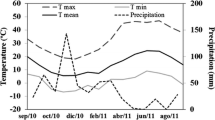Abstract
Net light-saturated photosynthetic rate (Amax) of field grown cocksfoot (Dactylis glomerata L.) leaves in a radiata pine (Pinus radiata D. Don) silvopastoral system (Canterbury, New Zealand) was measured at different times under severe shade (85–95 µmol m–2 s–1 photosynthetic photon flux density, PPFD) and in full sunlight (1900 µmol m–2 s–1 PPFD). The aim was to integrate individual functions for Amax against air temperature (2 to 37 ºC), water status, expressed as pre-dawn leaf water potential (ψlp) (-0.01 to −1.6 MPa), herbage nitrogen (N) (1.5 to 5.9%), regrowth duration (20 to 60 days) and time under shade (1 to 180 min) into a multiplicative model. The highest Amax value obtained was 27.4 µmol CO2 m–2 s–1 in non-limiting conditions with full sunlight. This value was defined as standardised dimensionless Amaxs = 1 for comparison of factor effects. The canopy temperature of the cocksfoot sward was up to 7.4 ºC cooler than air temperature for plants under shade. Therefore, canopy temperature was used to predict Amax. The only interaction was between time under severe shade (5% of the open PPFD) and water stress (ψlp = −0.4 to −1.3 MPa) and this was included in the model. Validation of this model indicated 78% of the variation in Amax could be accounted for using these five factors by the addition of the interaction function. This model could be used to assist the prediction of pasture growth in silvopastoral systems through incorporation into a canopy photosynthesis model.
Similar content being viewed by others
References
Alvino A., Centritto M. and De Lorenzi F.1994. Photosynthesis response of sunlit and shade pepper (Capsicum annuum) leaves at different positions in the canopy under two water regimes.Australian Journal of Plant Physiology21: 377–391.
Braziotis D.C. and Papanastasis V.P.1995. Seasonal changes of understorey herbage yield in relation to light intensity and soil moisture content in a Pinus pinaster plantation.Agroforestry Systems29: 91–105.
Chaves M.M.1991. Effects of water deficits on carbon assimilation.Journal of Experimental Botany42: 1–16.
Fraser P.M., Cameron K.C. and Sherlock R.P.1994. Lysimeter study of the rate of nitrogen in animal urine returns to irrigated pasture.European Journal of Soil Science45: 439–447.
Hatfield J.L.1985. Wheat canopy resistance determined by energy balance techniques.Agronomy Journal77: 279–283.
Joshi M.R., Lucas R.J., Sedcole J.R., Pollock K.M., Moot D.J. and Mead D.J.1999. Shading effects of Pinus radiata on productivity and feeding value of orchardgrass pasture.Agroforestry Forum9: 17–19.
Kirschbaum M.U.F., Gross L.J. and Pearcy R.W.1988. Observed and modelled stomatal responses to dynamic light environments in the shade plant Alocasia macrorrhiza.Plant, Cell and Environment11: 111–121.
Knapp A.K. and Smith W.K.1990. Contrasting stomatal responses to variable sunlight in two subalpine herbs.American Journal of Botany77: 226–231.
Mead D.J., Lucas R.J. and Mason E.G.1993. Studying interactions between pastures and Pinusradiata in Canterbury's subhumid temperate environment-the first two years.New Zealand Forestry38: 26–31.
Miah M.G., Garrity D.P. and Aragon M.L.1995. Light availability to the understorey annual crops in an agroforestry system. In: Sinoquet H. and Cruz P. (eds), Ecophysiology of Tropical Intercropping, pp. 99–107. Institute National de la Recherche Agronomique, Paris.
Nobel P.S.1999. Physicochemical and Environmental Plant Physiology.Academic Press, London, 474pp.
Ong C.K., Corlett J.E., Singh R.P. and Black C.R.1991. Above and below interactions in agroforestry systems.Forest Ecology and Management45: 45–56.
Pearcy R.W., Krall J.P. and Sassenrath-Cole G.F.1996. Photosynthesis in fluctuating light environments. In: Baker N.R. (ed.), Photosynthesis and the Environment, pp. 321–346. Kluwer Academic Publishers, Dordrecht.
Peri P.L., McNeil D.L., Moot D.J., Varella A.C. and Lucas R.J.2002a. Net photosynthetic rate of cocksfoot leaves under continuous and fluctuating shade conditions in the field.Grass and Forage Science57: 157–170.
Peri P.L., Moot D.J., McNeil D.L., Varella A.C. and Lucas R.J.2002b. Modelling net photosynthetic rate of field grown cocksfoot leaves under different nitrogen, water and temperature regimes.Grass and Forage Science57: 61–71.
Peri P.L., Moot D.J., McNeil D.L. and Lucas R.J.2003. Modelling net photosynthetic rate of field grown cocksfoot leaves to acount for regrowth duration.New Zealand Journal of Agricultural Research46: 105–115.
Sheehy J.E. and Cooper J.P.1973. Light interception, photosynthetic activity, and crop growth rate in canopies of six temperate forage grasses.Journal of Applied Ecology 10: 239–250.
Sheehy J.E.1977. Microclimate, canopy structure and photosynthesis in canopies of three contrasting temperate forage grasses. III. Canopy photosynthesis, individual leaf photosynthesis and the distribution of current assimilate.Annals of Botany41: 593–604.
Sinclair T.R. and Muchow R.C.1999 Radiation use efficiency.Advances in Agronomy65: 215–265.
Thornley J.H.M.1998. Grassland Dynamics: An Ecosystem Simulation Model.CAB International, Wallingford, 241pp.
Tinoco-Ojanguren C. and Pearcy R.W.1993. Stomatal dynamics and its importance to carbon gain in two rainforest Piper species.Oecologia94: 395–402.
Zhang H., Sharifi M.R. and Nobel P.S.1995. Photosynthetic characteristics of sun versus shade plants of Encelia farinosa as affected by photosynthetic photon flux density, intercellular CO2 concentration, leaf water potential, and leaf temperature.Australian Journal of Plant Physiology22: 833–841.
Author information
Authors and Affiliations
Corresponding author
Rights and permissions
About this article
Cite this article
Peri, P., Moot, D. & McNeil, D. An integrated model for predicting maximum net photosynthetic rate of cocksfoot (Dactylis glomerata) leaves in silvopastoral systems. Agroforestry Systems 58, 173–183 (2003). https://doi.org/10.1023/A:1026032721425
Issue Date:
DOI: https://doi.org/10.1023/A:1026032721425




